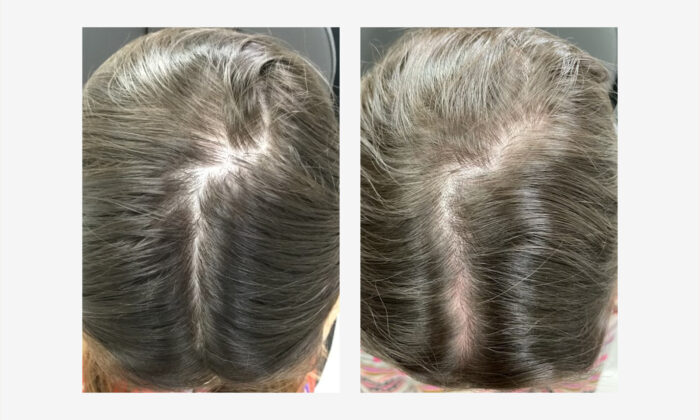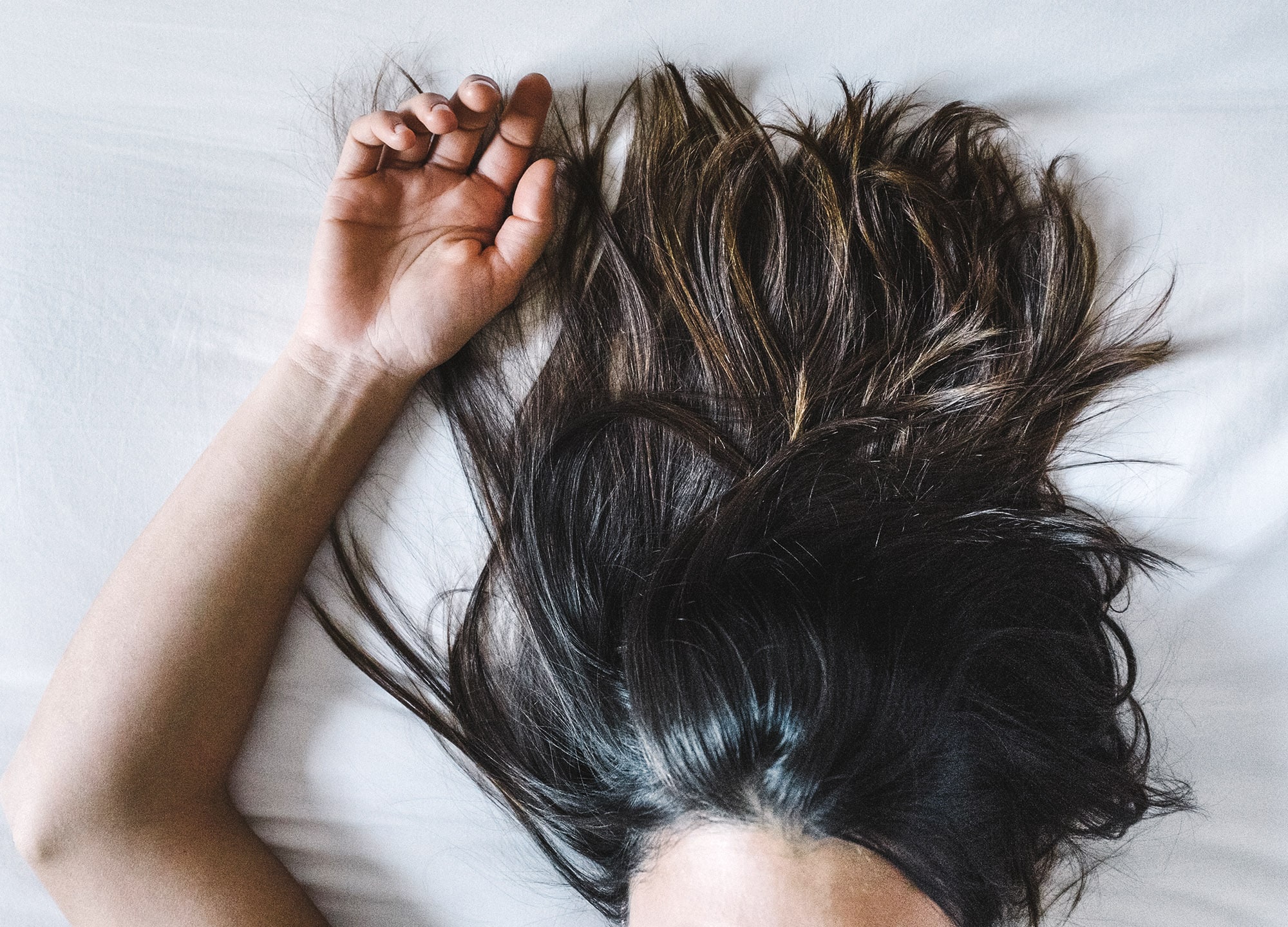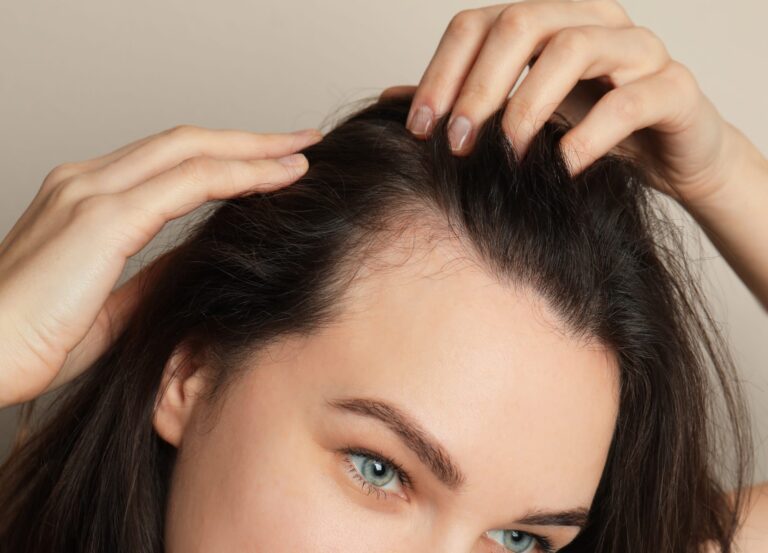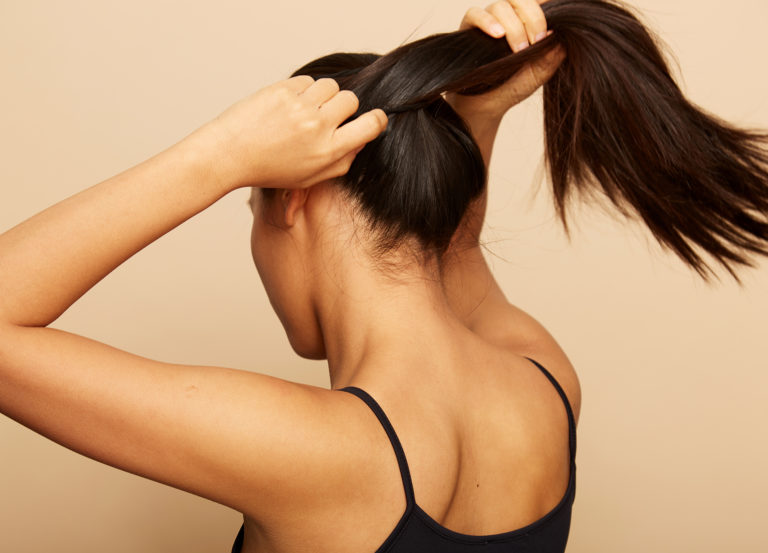My hair has always sort of been my thing. Growing up as the daughter of a hairdresser—in the ’80s and ’90s, no less—meant having an actual hairstyle from a very young age. Curling irons, spiral perms, and cans of Shaper Plus molded not only my hair but the memories of my youth.
In my later years of high school, bangs mercifully unfurled and trends relaxed. Among my classmates, the look was long and loose (yet still semi-poufed, because 1994)—and my thick, straight hair naturally conformed. (This may have been the only effortless moment of my teens, mind you.) By college, I’d abandoned all manner of styling aids, fully embracing the long, center-parted vibe that ruled among a certain set of girls on campus.
When I moved to New York City and began working in beauty, the hairstylists I encountered, in salons and on sets, always remarked about the health and heft of my hair. Its substantial weight even influenced my wedding look: a low, artfully rumpled bun, specifically designed to work in harmony with gravity.
It may sound strange (and slightly shallow, perhaps) for hair to be so poignantly woven into someone’s narrative—but looking back, mine has always played some small but meaningful role. So when I turned 40 and started losing this part of myself, of my identity, it threw me. Initially, I denied it—or, more accurately, tried to convince myself it wasn’t happening. Haven’t I always shed strands in the shower? Isn’t this a normal amount to see tangled in the boar bristles of my Mason Pearson…and strewn across my pillowcase and wrapped around the spinning brush of the vacuum? (I’d read that people typically lose 100–150 hairs a day, but at the time, I was too scared to tally my output.) In 2019, I went to an aesthetics meeting in Washington, D.C. While getting ready one evening before the full-length mirror, I noticed more scalp peering back at me than ever before—startling, yes, but… it must be this horrid hotel lighting.
Eventually I came to accept it: for no reason that I could reliably pinpoint, my hair was falling out. Privately, I was crushed, rattled, scared—even a little embarrassed for caring about something so seemingly trivial.
The treatment I tried and provider I trusted
This past summer, I reached out to Dr. Caroline Chang, a board-certified dermatologist in East Greenwich, Rhode Island. She generously offered to assess and treat my thinning hair with a form of platelet-rich plasma (PRP) called PRFM, or platelet-rich fibrin matrix. As with traditional PRP, the PRFM treatment starts with a blood draw. Your provider collects a couple of vials of blood from your arm and spins them down in a centrifuge, to isolate the plasma (aka “liquid gold”), which is rich in growth factors. But with PRFM, rather than directly injecting that plasma into your scalp, the doctor transfers it into a separate vial laced with a calcium chloride solution. (The particular PRFM system Dr. Chang uses is made by Selphyl.) This extra step “takes the platelets and creates a scaffold,” she says. “So now your platelets are almost holding hands, and because they’re all linked together, they’re able to stay in the place we inject them for longer rather than dispersing upon injection.”
The platelets are thought to “stimulate oxygen and blood flow to the hair follicles, creating a better environment for hair growth,” Dr. Chang explains. Ideally, patients come in for three treatments, six weeks apart, and then schedule a three-month follow-up, to check for regrowth. For those who see results and want to maintain them, Dr. Chang recommends twice-yearly booster shots. However, she cautions, PRP and PRFM outcomes are highly variable, with some folks seeing improvement after one or two rounds and others not responding at all. In other words, it’s a gamble—and, at roughly $600 per treatment, not a cheap one.
What the PRFM treatment was like
During my first appointment, Dr. Chang analyzed my scalp and asked about the events surrounding my hair loss. While I couldn’t connect my abrupt and pronounced shedding to any one event—other than aging—her examination and our conversation led to a diagnosis of two distinct types of hair loss: androgenetic alopecia (AGA) and telogen effluvium (TE).
AGA, or female/male-pattern hair loss, is hereditary and, as the name suggests, hormonal. It’s marked by a miniaturization of the follicles—strands become finer and shorter—and a widening of the part, particularly at the crown of the head. “Generally, on our first evaluation of the scalp, we divide the hair right down the middle, wherever your natural part falls, and push it down, to see how wide it is and if it widens toward the back,” she explains. While I’d noticed more scalp showing only at the front of my hairline, Dr. Chang pointed out that my partline definitely expanded toward the back of my head, signaling AGA.
TE is a more diffuse, stress-induced shedding, which typically presents several months after a traumatic event—and navigating one’s family through a pandemic absolutely qualifies. With TE, our hair growth cycle gets out of whack, and an inordinate number of strands shift into the telogen, or resting, phase all at once—and then fall out, in unison, a few months later. (Doctors normally diagnose TE by doing a pull test—lightly tugging at sections of hair, to see how many strands come loose at the root with their white telogen bulbs attached. By the time I sought treatment, however, my shedding had largely subsided, so we skipped this step.) While TE is temporary and usually resolves on its own once the instigating stressor has passed, the chronic worry and anxiety we’re all experiencing right now can lead to protracted periods of shedding and loss. As the hair cycle eventually normalizes, baby hairs begin to crop up.
“We’re finding that PRP and PRFM are useful for a lot of different hair loss conditions,” says Dr. Chang. In cases of TE and AGA, the injections act like fertilizer, she adds, encouraging miniaturized and baby hairs to sprout and develop a little faster.
After Dr. Chang drew my blood, spun it down, and transformed my platelets into PRFM, we had six syringes full of injectable liquid gold—which translated to roughly 60 needle pokes to my scalp. Dr. Chang didn’t numb me for the procedure, because anesthetic creams in hair are messy and lidocaine injections hurt as much, if not more, than the PRP sticks. Instead, she moved quickly, distracting with chitchat and vibration. The actual injection process takes only a minute or two, with the ouchiest pokes being those closest to the hairline. The Selphyl system, according to Dr. Chang, is known to be milder than others. “Less injection-site pain was the biggest factor that led me to choose this kit,” she says. “A lot of kits burn when you inject the product back into the scalp. This one still hurts, because of the needle pokes, but the reports were that it didn’t burn as much, and I think that’s due to the fibrin matrix.”
The recovery
It’s an odd sensation, having several ccs of fluid forced into the relatively tight space between your scalp and skull. After each of my three appointments, I left Dr. Chang’s office feeling heavy-headed and a bit tender. My roots were slick from blood and rubbing alcohol, but since I was always going straight home, mussed hair was a nonissue.
After my first session, I remember it smarting a surprising amount to raise my brows or sneeze or smile big—most expressions, you come to realize, cause the skin on your head to shift slightly. On subsequent visits with Dr. Chang, I knew what to expect, so while the post-shot experience was hardly pleasant, I wasn’t nearly as fazed. I could easily jump back into writing and parenting when I got home from each 45-minute appointment.
Dr. Chang advised me to skip shampooing and working out the day of treatment. The next day, I could wash my hair—but very gently (you want the platelets to remain where injected for as long as possible, plus my scalp was still pretty sore). As for exercise, I did fairly moderate, 20-minute Peloton rides on the days after each round of shots and always felt fine. By three days out, my head felt 100% back to normal.
Related: More Women Are Opening up About Hair Loss—And That’s a Good Thing
The results

I tend not to notice subtleties, so I wasn’t expecting to register much of a change in my hair throughout the PRFM process. But some time after my second appointment, my hairline started looking a little fuzzier—and those baby hairs brought such relief. It wasn’t until my third visit though, when Dr. Chang smooshed down my naturally crooked center part and took “after” photos, that I saw how the crown of my head had filled in. Astonishing, really.
When reporting on hair loss in the past, I’d been told that regardless of the specific treatment patients seek—be it a form of PRP or an at-home solution, like Rogaine or supplements—that sometimes just taking action and attempting to stem the shedding or spark regrowth can help abate the panic and anxiety that inevitably fuel hair loss. And to this fact, I can now personally attest. Even before I gleaned any hint of efficacy from my injections, I felt more hopeful when looking in the mirror. This sounds corny, overly optimistic, and truly not at all like me, but I felt empowered—like the fate of my hair was at least somewhat in my hands (or Dr. Chang’s hands, more precisely)—and this knowledge instilled a sense of calm.
While my hair hasn’t rebounded to its high school glory and likely never will, these baby hairs are giving me life. And honestly, as I approach my 44th birthday—and the pandemic nears its first and, hopefully, last—I’m seeing even modest gains as cause for celebration.











